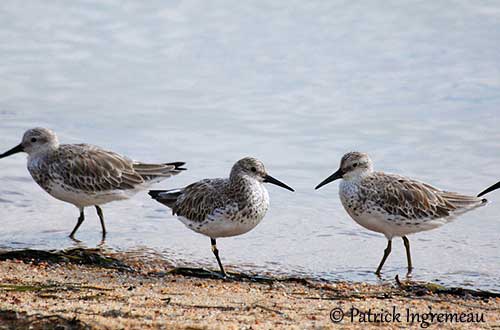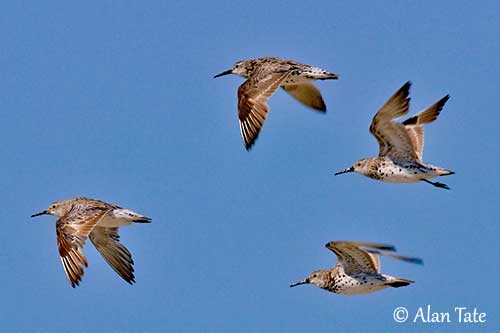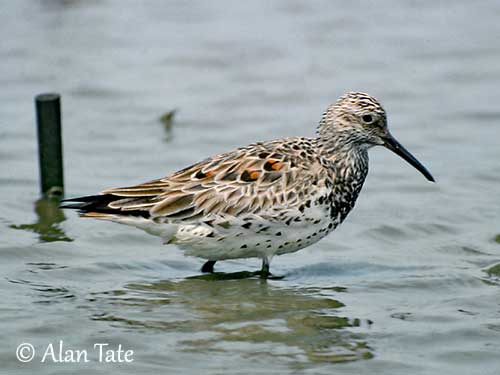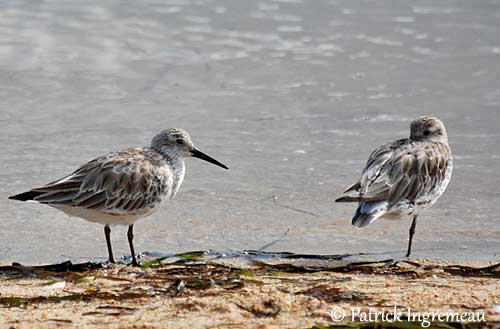
PROTECTION / THREATS / STATUS:
The Great Knot is threatened by the loss of intertidal habitats used as stopovers, due to expansion of aquaculture and agriculture, human disturbance and pollution involving degradation of wetlands in the Yellow Sea region. The same problem occurs in South Korea.
In Philippines, India and Australia, they are threatened by mangrove afforestation and degradation of the habitat by intensive fishing activities and human developments.
The global population was estimated to number 380,000 individuals in 2006, but a new estimate in 2007 placed this population in the band 292,000/295,000 individuals.
This population is rapidly declining, and the Great Knot is currently listed as Endangered.
Fr: Bécasseau de l'Anadyr
Ang: Great Knot
All: Großer Knutt
Esp: Correlimos Grande
Ita: Piovanello gigante
Nd: Grote Kanoet
Sd: kolymasnäppa
Photographers:
Patrick Ingremeau
TAMANDUA
Otto Plantema
Trips around the world
Alan & Ann Tate
AA Bird Photography
Text by Nicole Bouglouan
Sources:
HANDBOOK OF THE BIRDS OF THE WORLD Vol 3 by Josep del Hoyo-Andrew Elliott-Jordi Sargatal - Lynx Edicions - ISBN: 8487334202
SHOREBIRDS by Peter Hayman, John Marchant and Tony Prater – Christopher Helm – 1986 – ISBN: 0747014035
GUIDE DES LIMICOLES de D. Taylor - Delachaux et Niestlé - ISBN : 2603014080
Avibase (Denis Lepage)
Birdlife International
Threatened Species of the Northern Territory
Office of Environment and Heritage
What Bird-The ultimate Bird Guide (Mitchell Waite)
Wikipedia, the free encyclopaedia
Great Knot
Calidris tenuirostris
Charadriiformes Order – Scolopacidae Family
INTRODUCTION:
The Great Knot is the largest member of the genus Calidris. It is very similar to the Surfbird and is the larger “cousin” of the Red Knot.
It breeds in NE Siberia and winters in SE Asia and Australia, with some wintering populations in Arabia, Pakistan, India and Bangladesh. It breeds at high elevations on high plateaus, but in winter, it can be found in coastal sheltered habitats such as bays, lagoons and estuaries. It feeds mainly on plant material during the breeding season, although the chicks are exclusively fed on insects, but molluscs, crustaceans and gastropods are included in the winter diet.
The Great Knot is threatened by habitat loss, especially the intertidal areas used as stopovers in the Yellow Sea region and in South Korea, caused by expansion of human activities.
The population is rapidly declining and the Great Knot is currently listed as Endangered.

DESCRIPTION OF THE BIRD:
Biometrics:
Length: 26-28 cm
Wingspan: 56-66 cm
Weight: 115-248 g
The Great Knot in breeding plumage is very similar to the Surfbird. The upperparts are greyish-brown with streaked pattern. It develops large rufous-brown spots and blackish tips on scapulars. The uppertail-coverts are white. Breast and flanks are heavily spotted black on the white underparts.
The head is streaked with black.
The bill is black but longer than that of the Surfbird. The eyes are dark brown. Legs and feet are dark grey to olive-green.
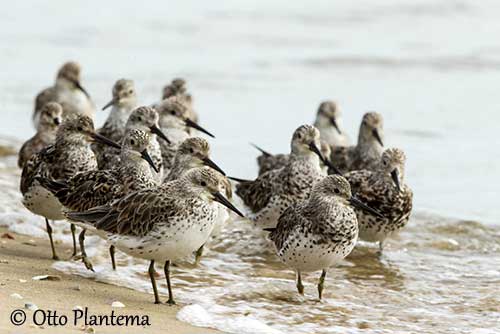
Male and female are similar.
The juvenile resembles adult in winter, but with darker and browner plumage. There are narrow whitish-buff fringes on the upperparts. Crown and breast are dark with brownish-buff wash.
RANGE:
The Great Knot breeds in NE Siberia in Russia. It winters mainly in SE Asia and S to Australia. Some populations also winter in Arabia, Pakistan, NW, S and NE India and Bangladesh.
HABITAT:
The Great Knot breeds in subarctic and montane tundra habitats in NE Siberia, between 300 and 1,700 metres of elevation, but generally below, around 1,000 metres in the E part of the breeding range, and slightly higher in the W part.
They nest in gravelling areas with lichens, herbs and heathers, but also in areas with thick layer of lichens and scattered dwarf trees such as Larix and Pinus pumila.
During winter, it occurs in sheltered coastal habitats with large intertidal mudflats, and can be found in estuaries, bays and lagoons, and occasionally on ocean beaches.
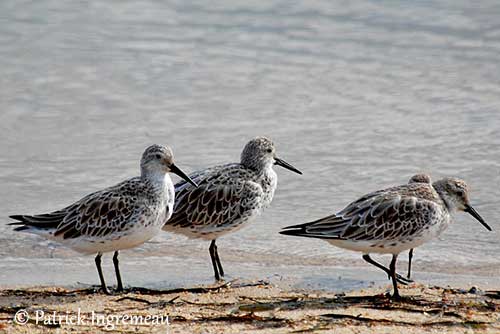
CALLS AND SONGS: SOUNDS BY XENO-CANTO
The Great Knot is usually silent, but it occasionally gives a disyllabic “nyut-nyut” call similar to that of the Red Knot. During the breeding season, we can also hear a soft whistling song.
BEHAVIOUR IN THE WILD:
The Great Knot feeds mainly on berries and some other plant material during the breeding season, but the chicks are exclusively fed on insects, larvae, beetles and spiders.
Outside this period, it feeds mainly on bivalves, snails, worms and crustaceans, and only occasionally on sea-cucumbers.
This species feeds by jabbing quickly the bill into the mud in the intertidal mudflats, often at water edge. It takes prey from mid-surface or just below it. It is often seen in mixed-species foraging groups.
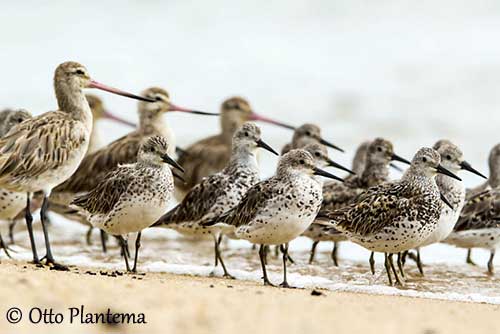
The Great Knot is territorial and monogamous, and usually returns to the same nesting sites. Both parents share the nesting duties, but the female leave the area after hatching and the male tends the chicks.
The Great Knot is a long-distance migrant and travels mainly along the coast with some stopovers. They often travel in mixed-species flocks. They arrive at their wintering grounds between August and October. They forage in large flocks at stopovers, but mainly in small groups on the wintering areas.
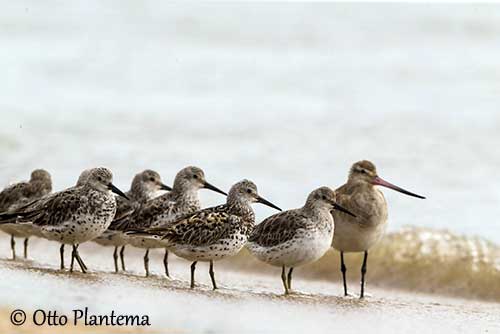
The Great Knot has the typical steady direct flight of all Calidris species, but the wingbeats are looser and slower.
REPRODUCTION OF THIS SPECIES:
The laying occurs between late May and late June. The density is about 13 pairs/9,5 km² of suitable habitat.
The nest is a shallow depression lined with lichens. It is placed on the ground among rocks and low vegetation.
The female lays 4 dark-coloured eggs with blackish speckles. The incubation is shared by both adults and lasts about three weeks. The female leaves the nesting site after hatching, while the male tends the chicks alone. The young leave the nest very soon and fledge 20-25 days after hatching, depending on weather conditions. They become independent several days later.
